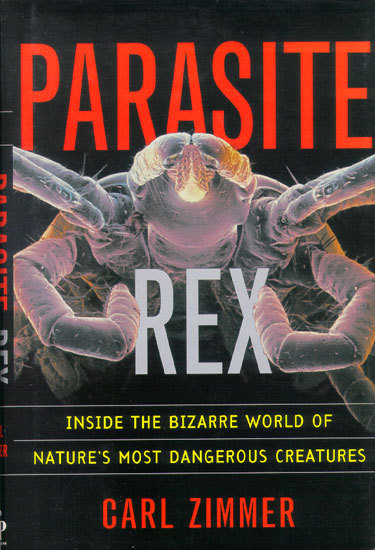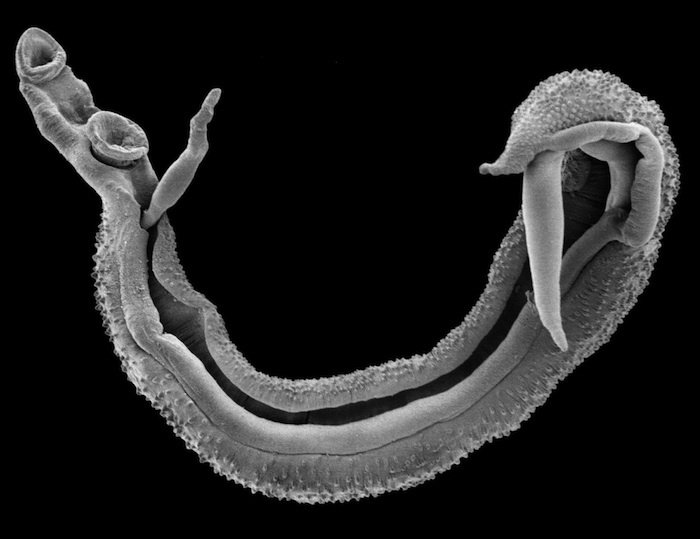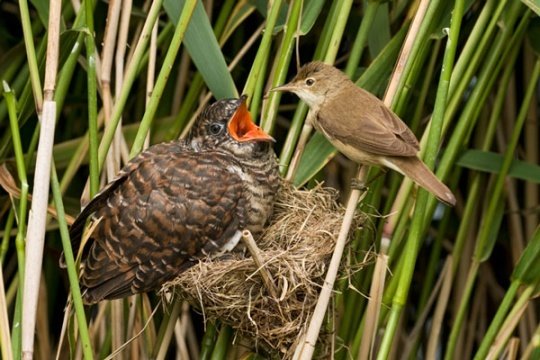Parasite Rex
By: Carl Zimmer
Project by: Nathan Allen
Parasite Rex
Publisher: Atria Books
Publishing date: 2000
Author: Carl Zimmer

{Parasite} an organism that lives in or on another organism (its host) and benefits by deriving nutrients at the host's expense.
Summary
Parasite Rex is about the complex life of parasites and the constantly changing field that studies them named parisitology. The book starts by explaining how early scientists discovered parasites and bacteria. Some of the scientists use unconventional methods to further their studies and disprove the idea that parasites spontaneously generated within the host. These early ideas help to establish that field of parasitology.


Summary
The book goes on to explain the different ways that parasites infect their hosts. One example includes a soil dwelling nematode that preys on a plant by rewiring its xylem and phloem to run backwards and supply the nematode with water and nutrients, while essentially killing the plant. Other parasites, like malaria, work on the cellular level and rewire red blood cells to their needs.


Plasmodium in blood cell
Soil nematode
Summary
Then the book explains how parasites interacts differently with the host's immune system. Parasites such Plasmodium live in blood cells that do not contain DNA, and therefore cannot alert the immune system of an intruder. The parasite Leishmania however has come up with a way to live within the macrophages designed to kill it, without being killed. Blood flukes, an African parasite, actually require a host with a healthy immune system to transport its young to the surface of the skin to begin their life cycle again in another host.


Blood Fluke
Leishmania
Summary
Parasites play a major role in biological systems and interact with other animals, including their hosts in many ways. One species of barnacle, Sacculina, crawls into the body of a crab, mates with other sacculina, and produces offspring under the crab. When this happens to a male crab, the parasite actually sterilizes the crab, makes it feel like a female, and the crab starts to care for the barnacles young. Flukes, found in marshes, may control the food chain. The parasite starts its life in a snail, that is eaten by a fish. The parasite then causes the fish to become very hungry causing it to move toward the water surface in search of food. This make it easier for a bird to then eat the fish.


Killifish
Crab carrying sacculina offspring
Summary
Parasites had to evolve after larger species so there was a host to feed off or take advantage of. Evolutionarily speaking, parasites developed to be less complex than their hosts, but have come up with specials ways to essentially use the host to their distinct needs. Two parasites, Plasmodium and Toxoplasma are believed to have diverged from a common ancestor because they can be killed using clindamycin, but are usually resistant to other drugs. Vertebrate parasites seemed to have developed later that simpler parasites. One example would the cuckoo bird that lays its egg in the nest of another bird. The egg hatches and the bird pushes the other babies out of the nest to horde the resources.


Cuckoo bird in warbler nest
Summary
The book reveals that parasites may be the reason, or at least a factor, for the rise of sexual reproduction. Animals that could reproduce both sexually and asexually would choose to do so asexually when there was no parasite pressure. If the pressure arose from parasites, the organisms would choose to reproduce with a mate, which would increase genetic variability and maybe increase resistance. To combat the immune resistance, parasites would then choose to reproduce with a mate (if they could) and increase their potency and ability to infect a host.
Summary
The migration of early man was also the migration of early parasites. The infection of parasites changed as humans changed the world around them. As animals were domesticated, blood flukes did not have to wait for an animal to be hunted, they would just live in the animals that humans raised. As forests were cut down, more still water showed up in puddles where mosquitoes would lay their eggs, increasing the amount of malaria. More people interacted meaning parasites had more hosts to choose from. Early humans had a rough time with parasites, as most of them did not even think of a small organism causing sickness. As medicine got better, the likelihood of parasite caused illness decreased.

Mosquito laying eggs on water

Domesticated Cattle
"According to one estimate, parasites may outnumber free-living species four to one. In other words, the study of life is, for the most part, parisitology."
-Carl Zimmer
Author's Style
Carl Zimmer is a very detailed writer and a knowledgeable one. The book was detailed, even in the gruesome parasite related parts. He defiantly did his homework on the subject, because he gives so many examples in each section that it starts to get overwhelming. He structured this book in 8 distinct body chapters with a prologue to explain the idea of parasites and the study of them.
How does it relate?
The information in the book relates to what I have learned in AP biology in many ways. The book talks about Plasmodium (malaria) that was covered on more than one occasion. Symbiotic relationships is also important in the book, especially parasitism, which is a topic covered in every biology class I have taken. Another way the book is connected to the curriculum is that it details the function of the immune system.
AP Big Ideas?
#1: The process of evolution drives the diversity and unity of life.
--The evolution of parasites has happened alongside the evolution of more complex hosts and is a constant back and forth pull between resistance and parasitic potency.
#2: Biological systems utilize free energy and molecular building blocks to grow, to reproduce and to maintain dynamic homeostasis.
--When fighting parasites the immune system (B and T cells) attack the invader to maintain homeostasis. Alternatively, the parasites are often utilizing the host to reproduce.
AP Big Ideas?
#3: Living systems store, retrieve, transmit and respond to information essential to life processes.
--Parasites communicate with one another and the hosts body, often through deception, to continue their life in the host. Memory T cells help to fight against a returning parasites, by storing information on the immune responses.
#4: Biological systems interact, and these systems and their interactions possess complex properties.
--Parasites are seen to be very important in maintaining some ecosystems where they interact with multiple organisms, which it needs to complete its life cycles.
What did I Learn?
After reading Parasite Rex I learned just how different and unique parasites could be. Some parasites require multiple hosts to complete a life cycle. Others can only survive in a single part of the body, and scientists have no idea how most of them reach that part. Certain parasites will live in their host for years until conditions are suitable for the next step in their life cycle. I learned that many parasites are insects and fish. Many wasps start their life devouring an innocent caterpillar that their mother had paralyzed. Certain catfish will live their entire lives within the gills of a larger fish, feeding on its blood. I also learned millions of people, especially in Europe, carry a parasite that settles in their brain for years. People who have blood disorders like sickle cell disease or ovalocytosis, are often resistant to malaria because the parasite will often die trying to multiply within the unusual blood cells.


Ovalocytosis
Tobacco Horn Beetle with parasites
Feelings/Emotions
After reading this book, I feel like parasites are EVERYWHERE and you cannot get away from them. Considering I can get brain-dwelling parasite from eating pork(although it is less common these days), I am glad I do not eat that much bacon or ham. I have a new understanding of parasites and just how abundant, important, and often dangerous, each of them can be. Parasitology is a very interesting field of study that I found myself thinking about throughout the book.
Photo Citations
http://www.labtimes.org/labtimes/ranking/2009_03/bild.jpg
http://www.mimg.ucla.edu/images/parasitology.jpg
http://faculty.yc.edu/ycfaculty/ags105/week10/soil_organisms/soil_fungi_2.jpg
https://eukaryography.files.wordpress.com/2011/07/plasmodium.jpg
http://photos.the-scientist.com/legacyArticleImages/2011/09/09_11_leishmania.jpg
http://www.nhm.ac.uk/natureplus/servlet/JiveServlet/showImage/38-3668-73496/Schistosoma+blood+fluke+worm+pair700p.jpg?fromGateway=true
http://i.ytimg.com/vi/LFaqeTauVhA/maxresdefault.jpg
http://upload.wikimedia.org/wikipedia/commons/3/3c/Fundulus_cingulatus.jpg
http://www.ppdictionary.com/parasites/gondii_t.jpg
http://songbirds-slaughter.org.uk/wp-content/themes/ThrillingTheme/thumb.php?src=http://songbirds-slaughter.org.uk/wp-content/uploads/2012/01/CuckooChickReedWarbler.jpg&h=400&w=540&zc=3&q=95
http://entnemdept.ufl.edu/creatures/aquatic/southern_house_mosquito06.jpg
http://www.thedesertreview.com/wp-content/upLoads/2013/11/cattle.jpg
http://webmedia.unmc.edu/alliedhealth/honeycutt/CLS416/06RBCWBCMorphologyReview/06RBCWBCMorphologyReview_slide0055_image024.jpg
http://www.harvesttotable.com/wp-content/uploads/2012/06/Parasitic-wasp-eggs-on-hornworm1.jpg